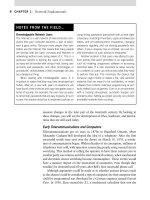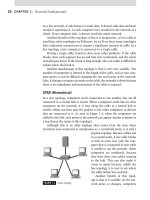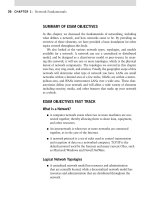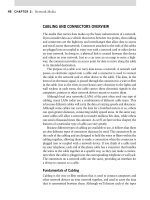CompTIA Network+ Certification Study Guide part 41 pot
Bạn đang xem bản rút gọn của tài liệu. Xem và tải ngay bản đầy đủ của tài liệu tại đây (99.19 KB, 10 trang )
CHAPTER 9: Security Standards and Services 386
This chapter also covers intrusion detection. It is important to under-
stand not only the concepts of intrusion detection but also the use and
placement of intrusion detection systems (IDSs) within a network infra-
structure. The placement of an IDS is critical to deployment success. We
also cover intrusion prevention systems (IPSs), honeypots, honeynets, and
incident response, and how they each have a part to play in protecting your
network environment.
HARDWARE AND SOFTWARE SECURITY DEVICES
Not all networks are created the same; thus, not all networks should be
physically laid out in the same fashion. The judicious usage of differing secu-
rity topologies in a network can offer enhanced protection and performance.
We discuss the components of a network and the security implications of
each. By understanding the fundamentals of each component and being able
to design a network with security considerations in mind, you will be able
to better prepare yourself and your environment for the inevitable barrage of
attacks that take place every day. With the right planning and design, you
will be able to minimize the impact of attacks while successfully protecting
important data.
Many tools exist today that can help you better manage and secure your
network environment. We focus on a few specific tools that give you the
visibility you need to keep your network secure, e.g., intrusion detection
and protection, firewalls, honeypots, content filters, and protocol analyzers.
These tools will allow you to monitor, detect, and contain malicious activity
in your environment. Each of these tools plays a different part in the day-
to-day routine of a network administrator, but all of them assist you to be
well armed and well prepared to handle what malicious attacks might come
your way.
Intrusion Detection and Preventions Systems
A successful security strategy requires many layers and components. Because
firewalls and other simple boundary devices lack some degree of intelligence
when it comes to observing, recognizing, and identifying attack signatures that
may be present in the traffic they monitor and the log files they collect, it is
often critical to select and deploy a more complex device that is capable of
advanced detection. This will allow for the best possible chance of the adminis-
trators in an environment receiving an early warning when there is an attack.
One of the components that can be deployed to perform these advanced
functions is the IDS. Intrusion detection is an important piece of security
Hardware and Software Security Devices 387
in that it acts as a detective control. As an example, consider a locked car
in a parking lot. Locking the car is much like securing the network. It pro-
vides security but only deters attacks. What if someone breaks in the locked
car; how would the driver detect this? In the world of automobile security
it could be accomplished with an alarm system. In the computer world,
this is done with an IDS. Although other boundary devices may collect all
the information necessary to detect (and often to foil) attacks that may be
getting started or are already underway, they have not been programmed
to inspect for and detect the kinds of traffic or network behavior patterns
that match known attack signatures or that suggest potential unrecognized
attacks may be incipient or in progress.
In a nutshell, the simplest way to define an IDS is to describe it as a spe-
cialized tool that knows how to read and interpret the contents of log files
from sensors placed on the network, routers, firewalls, servers, and other
network devices. Furthermore, an IDS often stores a database of known
attack signatures and can compare patterns of activity, traffic, or behavior it
sees in the logs it is monitoring against those signatures to recognize when
a close match between a signature and current or recent behavior occurs. At
that point, the IDS can issue alarms or alerts, take various kinds of auto-
matic action ranging from shutting down Internet links or specific servers
to launching backtrace efforts, and make other active attempts to identify
attackers and actively collect evidence of their nefarious activities.
By analogy, an IDS does for a network what an antivirus software package
does for files that enter a system: it inspects the contents of network traffic
to look for and deflect possible attacks, just as an antivirus software package
inspects the contents of incoming files, e-mail attachments, active Web con-
tent, and so forth to look for virus signatures (patterns that match known
malicious software [malware]) or for possible malicious actions (patterns of
behavior that are at least suspicious, if not downright unacceptable).
To be more specific, intrusion detection means detecting unauthorized
use of or attacks on a system or network. An IDS is designed and used to
detect and then to deflect or deter (if possible) such attacks or unauthorized
Exam Warning
To eliminate confusion on the Network+ exam, the simplest definition of IDS is a device
that monitors and inspects all inbound and outbound network traffic, and identifies
patterns that may indicate suspicious activities or attacks. Do not confuse this with a
firewall, which is a device that inspects all inbound and outbound network traffic looking
for disallowed types of connections.
CHAPTER 9: Security Standards and Services 388
use of systems, networks, and related resources. Like firewalls, IDSs may
be software-based or may combine hardware and software (in the form of
preinstalled and preconfigured stand-alone IDS devices). There are many
opinions as to what is the best option. For the exam, what’s important
is to understand the differences. Often, IDS software runs on the same
devices or servers where firewalls, proxies, or other boundary services oper-
ate; however an IDS is not running on the same device or server where the
firewall or other services are installed to monitor those devices closely and
carefully. Although such devices tend to operate at network peripheries, IDS
can detect and deal with insider attacks as well as external attacks as long
as the sensors are appropriately placed to detect such attacks.
On the flip side of the coin, why not stop these intrusions before they
have breached the border and have made it to your IDS? Intrusion protec-
tion systems (IPSs) are a possible line of defense against system attacks. By
being proactive and defensive in your approach, as opposed to reactive, you
stop more attempts at network access at the door. IPSs typically exist at the
boundaries of your network infrastructure and function much like a fire-
wall. The big distinction between IPS and firewalls is that IPSs are smarter
devices in that they make determinations based on content as opposed to
ports and protocols. By being able to examine content at the application
layer, the IPS can perform a better job at protecting your network from
things like worms and Trojans, before the destructive content is allowed
into your environment.
An IPS is capable of responding to attacks when they occur. This behav-
ior is desirable from two points of view. For one thing, a computer system
can track behavior and activity in near–real time and respond much more
quickly and decisively during the early stages of an attack. Because automa-
tion helps hackers mount attacks, it stands to reason that it should also
help security professionals fend them off as they occur. For another thing,
an IPS can stand guard and run 24 hours per day/7 days per week, but
network administrators may not be able to respond as quickly during off
hours as they can during peak hours. By automating a response and moving
these systems from detection to prevention, they actually have the ability
to block incoming traffic from one or more addresses from which an attack
originates. This allows the IPS the ability to halt an attack in process and
block future attacks from the same address.
Difference between Network Intrusion Detection System
and Network Intrusion Protection System
Network intrusion detection systems (NIDSs) and network intrusion pro-
tection systems (NIPSs) are similar in concept, and NIPS is at first glance
what seems to be an extension of NIDS, but in actuality the two systems
Hardware and Software Security Devices 389
are complementary and behave in a cooperative fashion. NIDS exists for
the purpose of catching malicious activity once it has arrived in your world.
Whether the NIDS in your demilitarized zone (DMZ) or your intranet cap-
tures the offending activity is immaterial; in both instances, the activity
is occurring within your network environment. With NIPS, the activity is
typically being detected at the perimeter and disallowed from entering the
network.
By deploying NIDS and NIPS, you provide for a multilayered defense,
and ideally your NIPS is able to thwart attacks approaching your network
from the outside in. Anything that makes it past the NIPS ideally would
then be caught by the NIDS inside the network. Attacks originating from
inside the network would also be addressed by the NIDS.
Exam Warning
Remember that an IPS is designed to be a preventive control. When an IDS identifies
patterns that may indicate suspicious activities or attacks, an IPS can take immediate
action that can block traffic, blacklist an IP address, or even segment an infected host to
a separate VLAN that can only access an antivirus server.
Network Design with NIDS and NIPS
An IDS and IPS are, quite simply, the high-tech equivalent of a burglar alarm
configured to monitor access points, hostile activities, and known intruders.
These systems typically trigger on events by referencing network activity
against an attack signature database. If a match is made, an alert takes place
and is logged for future reference. The makeup of this signature database is
the Achilles heel of these systems.
Attack signatures consist of several components used to uniquely
describe an attack. The signature is a kind of detailed profile that is com-
piled by doing an analysis of previous successful attacks. An ideal signature
would be one that is specific to the attack while being as simple as possible
to match with the input data stream (large complex signatures may pose a
serious processing burden). Just as there are varying types of attacks, there
must be varying types of signatures. Some signatures define the character-
istics of a single IP option, perhaps that of an Nmap port scan, while others
are derived from the actual payload of an attack.
Most signatures are constructed by running a known exploit several
times, monitoring the data as it appears on the network, and looking for
a unique pattern that is repeated on every execution. This method works
fairly well at ensuring that the signature will consistently match an attempt
CHAPTER 9: Security Standards and Services 390
by that particular exploit. Remember, the idea is for the unique identifica-
tion of an attack, not merely the detection of attacks.
A computing system, in its most basic abstraction, can be defined as a
finite-state machine, which literally means that there are only a specific pre-
defined number of states that a system may attain. This limitation hinders the
IDS, in that it can be well armed at only a single point in time (in other words,
as well armed as the size of its database). This poses several problems:
First, how can one have foreknowledge of the internal characteris-
tics that make up an intrusion attempt that has not yet occurred?
You cannot alert on attacks you have never seen.
Second, there can be only educated guesses that what has happened
in the past may again transpire in the future. You can create a
signature for a past attack after the fact, but that is no guarantee
you will ever see that attack again.
Third, an IDS may be incapable of discerning a new attack from the
background white noise of any network. The network utilization
may be too high or many false positives cause rules to be disabled.
Finally, the IDS may be incapacitated by even the slightest modifica-
tion to a known attack. A weakness in the signature matching pro-
cess, or more fundamentally, a weakness in the packet analysis engine
(packet sniffing/reconstruction) will thwart any detection capability.
The goals of an attacker in relation to IDS evasion are two-fold:
To evade detection completely
To use techniques and methods that increase the processing load of
the IDS sensor significantly
As more methods are used by attackers on a wide scale, more vendors
will be forced to implement more complex signature matching and packet
Exam Warning
Signatures are defined as a set of actions or events that constitute an attack pattern.
They are used for comparison in real time against actual network events and condi-
tions to determine if an active attack is taking place against the network. The drawback
of using attack signatures for detection is that only those attacks for which there is a
released signature will be detected. It is vitally important that the signature database be
kept up-to-date.
Hardware and Software Security Devices 391
analysis engines. These complex systems will undoubtedly have lower
operating throughputs and will present more opportunities for evasion. The
paradox is that the more complex a system becomes, the more opportunities
there are for vulnerabilities.
A huge number of potential vendors can provide IDS and IPS products to
companies and organizations. Without specifically endorsing any particular
vendor, the following products offer some of the most widely used and best-
known solutions in this product space:
Cisco Systems is best known for its switches and routers but offers
significant firewall and intrusion detection products as well
(www.cisco.com).
GFI LANguard is a family of monitoring, scanning, and file
integrity check products that offer broad intrusion detection and
response capabilities (www.gfi.com/languard/).
TippingPoint, a division of 3Com, makes an inline IPS device that
is considered one of the first IPS devices on the market.
Internet Security Systems (ISSs) (a division of IBM) offers a
family of enterprise-class security products called RealSecure,
which includes comprehensive intrusion detection and response
capabilities (www.iss.net).
McAfee offers the IntruShield IPSs that can handle gigabit speeds
and greater (www.mcafee.com).
Sourcefire is the best-known vendor of open source IDS software as
they are the developers of Snort, which is an open source IDS applica-
tion that can be run on Windows or Linux systems (www.snort.org).
HEAD OF THE CLASS…
Weighing IDS Options
In addition to the various IDS and IPS vendors men-
tioned in the list below, judicious use of a good Inter-
net search engine can help network administrators
identify more potential suppliers than they would ever
have the time or inclination to investigate in detail.
That is why we also urge administrators to consider
an alternative: deferring some or all the organization’s
network security technology decisions to a special type
of outsourcing company. Known as managed security
services providers (MSSPs), these organizations help
their customers select, install, and maintain state-
of-the-art security policies and technical infrastruc-
tures to match. For example, Guardent is an MSSP that
includes comprehensive firewall IDS and IPSs among
its various customer services; visit www. guardent.com
for a description of the company’s various service
programs and offerings.
CHAPTER 9: Security Standards and Services 392
A clearinghouse for ISPs known as ISP-Planet offers all kinds of interest-
ing information online about MSSPs plus related firewall, Virtual private
network (VPN), intrusion detection, security monitoring, antivirus, and
other security services. For more information, visit any or all the following
universal resource locators (URLs):
ISP-Planet Survey: managed Security Service Providers, partici-
pating provider’s chart, www.isp-planet.com/technology/mssp/
participants_chart.html.
Managed firewall services chart, www.isp-planet.com/technology/
mssp/firewalls_chart.html.
Managed virtual private networking chart, www.isp-planet.com/
technology/mssp/services_chart.html.
Managed intrusion detection and security monitoring, www. isp-
planet.com/technology/mssp/monitoring_chart.html.
Managed antivirus and managed content filtering and URL block-
ing, www.isp-planet.com/technology/mssp/mssp_survey2.html.
Managed vulnerability assessment and emergency response and
forensics, www.isp-planet.com/technology/mssp/mssp_survey3.html.
Firewalls
A firewall is the most common device used to protect an internal network
from outside intruders. When properly configured, a firewall blocks access to
an internal network from the outside, and blocks users of the internal net-
work from accessing potentially dangerous external networks or ports.
Let’s look at three firewall technologies:
Packet filtering
Application layer gateways
Stateful inspection
HEAD OF THE CLASS…
Getting Real Experience Using an IDS
One of the best ways to get some experience using
IDS tools, such as TCPDump and Snort, is to check
out one of the growing number of bootable Linux OSs.
Because all the tools are precompiled and ready to
run right off the CD, you only have to boot the com-
puter to the disk. One good example of such a boota-
ble disk is Backtrack. This CD-based Linux OS actually
has over 300 security tools that are ready to run. Learn
more at www.remote-exploit.org/backtrack.html.
Hardware and Software Security Devices 393
All these technologies have advantages and disadvantages. A packet-filtering
firewall works at the network layer of the Open Systems Interconnection (OSI)
model and is designed to operate rapidly by either allowing or denying packets.
The second generation of firewalls is called circuit level firewalls, but this type
has been largely disbanded as later generations of firewalls absorbed their func-
tions. An application layer gateway operates at the application layer of the OSI
model, analyzing each packet and verifying that it contains the correct type of
data for the specific application it is attempting to communicate with.
A stateful inspection firewall checks each packet to verify that it is an
expected response to a current communications session. This type of fire-
wall operates at the network layer but is aware of the transport, session, pre-
sentation, and application layers and derives its state table based on these
layers of the OSI model. Another term for this type of firewall is a “deep
packet inspection” firewall, indicating its use of all layers within the packet
including examination of the data itself.
To better understand the function of these different types of firewalls, we
must first understand what exactly the firewall is doing. The highest level of
security requires that firewalls be able to access, analyze, and use communi-
cation information, communication-derived state, and application-derived
state, and be able to perform information manipulation. Each of these terms
is defined below:
Communication Information Information from all layers in the
packet.
Communication-derived State The state as derived from previous
communications.
Application-derived State The state as derived from other applications.
Information Manipulation The ability to perform logical or arith-
metic functions on data in any part of the packet.
HEAD OF THE CLASS…
What Is a Firewall?
A firewall is a security system that is intended to protect
an organization’s network against external threats,
such as hackers, coming from another network, such
as the Internet.
Simply put, a firewall is a hardware or software
device used to keep undesirables electronically out of
a network the same way that locked doors and secured
server racks keep undesirables physically away from
a network. A firewall filters traffic crossing it (both
inbound and outbound) based on rules established by
the firewall administrator. In this way, it acts as a sort of
digital traffic cop, allowing some (or all) of the systems
on the internal network to communicate with some of
the systems on the Internet, but only if the communi-
cations comply with the defined rule set.
CHAPTER 9: Security Standards and Services 394
Different firewall technologies support these requirements in different
ways. Again, keep in mind that some circumstances may not require all
these but only a subset. In that case, it is best to go with a firewall technol-
ogy that fits the situation rather than one that is simply the newest tech-
nology. Table 9.1 shows the firewall technologies and their support of these
security requirements.
In the following sections, we review some of the different types of fire-
walls that exist today.
Proxy Servers
A proxy server is a server that sits between an intranet and its Internet con-
nection. Proxy servers provide features such as document caching (for faster
browser retrieval) and access control. Proxy servers can provide security for a
network by filtering and discarding requests that are deemed inappropriate by
an administrator. Proxy servers also protect the internal network by masking
all internal IP addresses – all connections to Internet servers appear to be
coming from the IP address of the proxy servers.
Network Layer Firewalls
A network layer firewall, or a packet-filtering firewall, works at the network
layer of the OSI model and can be configured to deny or allow access to spe-
cific ports or IP addresses. A firewall works in two directions. It can be used
to keep intruders at bay, and it can be used to restrict access to an external
network from its internal users. Why do this? A good example is found in
some Trojan horse programs. When Trojan horse applications are initially
installed, they report back to a centralized location to notify the author or
distributor that the program has been activated. Some Trojan horse applica-
tions do this by reporting to an Internet Relay Chat (IRC) channel or by con-
necting to a specific port on a remote computer. By denying access to these
external ports in the firewall configuration, you can prevent these malicious
programs from compromising their internal network.
Table 9.1
Firewall Technologies
Requirement Packet Filtering
Application Layer
Gateways
Stateful
Inspection
Communication information Partial Partial Yes
Communication-derived state No Partial Yes
Application-derived state No Yes Yes
Information manipulation Partial Yes Yes
Hardware and Software Security Devices 395
As a network administrator, you must make a choice between two dis-
tinct base firewall policies. When creating packet-filtering firewall rules, the
choices typically are “allow by default” and “deny by default”. “Allow by
default” allows all traffic to pass through the firewall except traffic that is
specifically denied. “Deny by default” blocks all traffic from passing through
the firewall, except for traffic that is explicitly allowed.
Deny by default is more often used and does provide a higher level of
security if implemented properly. This policy follows the general security
concept of restricting all access to the minimum level necessary to support
business needs. The best practice when configuring firewalls with this policy
type is to deny access to all ports except those that are absolutely necessary.
For example, if you are configuring an externally facing firewall for a DMZ,
you may want to deny all ports except port 443 (the Secure Sockets Layer
[SSL] port) require all connections coming in to the DMZ to use Hypertext
Transfer Protocol Secure (HTTPS) to connect to the Web servers. Although
it is not practical to assume that only one port will be needed, the idea is
to keep access to a minimum by following the best practice of denying by
default.
Out of 65,535 total ports, ports 0 through 1,023 are considered well-
known ports. These ports are used for specific network services and should
be considered the only ports allowed to transmit traffic through a firewall.
Ports outside the range of 0 through 1,023 are either registered ports or
dynamic/private ports.
User ports range from 1,024 through 49,151
Dynamic/private ports range from 49,152 through 65,535
If there are no specialty applications communicating with a network,
any connection attempt to a port outside the well-known ports range should
be considered suspect. Although there are some network applications that
work outside of this range that may need to go through a firewall, they
should be considered the exception and not the rule. With this in mind,
ports 0 through 1,023 still should not be enabled. Many of these ports also
offer vulnerabilities; therefore, it is best to continue with the best practice of
denying by default and only opening the ports necessary for specific needs.
For a complete list of assigned ports, visit the Internet Assigned Num-
bers Authority (IANA) at www.iana.net. The direct link to their list of ports
is at www.iana.org/assignments/port-numbers. The IANA is the centralized
organization responsible for assigning IP addresses and ports. They are also
the authoritative source for which ports applications are authorized to use
for the services the applications are providing.









